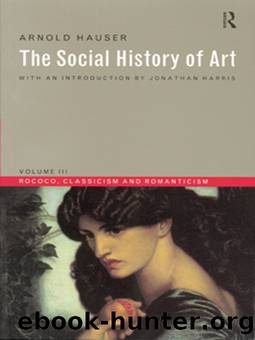Social History of Art, Volume 3 by Hauser Arnold; Harris Jonathan; Harris Jonathan

Author:Hauser, Arnold; Harris, Jonathan; Harris, Jonathan
Language: eng
Format: epub
Publisher: Routledge
Published: 1999-09-14T16:00:00+00:00
5.
REVOLUTION AND ART
The eighteenth century is full of contradictions. It is not only that its philosophical attitude wavers between rationalism and anti-rationalism, but its artistic aims are also dominated by two opposite tendencies and at some times approach a strictly classicistic, at others a more unrestrained pictorial conception. And like the rationalism of the period, its classicism is also difficult to define and open to various sociological interpretations, since it is sustained alternately by courtly-aristocratic and middle-class strata of society and ends by developing into the representative artistic style of the revolutionary bourgeoisie. The fact that David’s painting becomes the official art of the Revolution only seems strange or even inexplicable, if one conceives the concept of classicism too narrowly and restricts it to the artistic aims of the upper, conservatively-minded classes. Classicistic art certainly tends towards conservatism and is well suited to represent authoritarian ideologies, but the aristocratic outlook often finds more direct expression in the sensualistic and exuberant baroque than in abstemious and matter-of-fact classicism. The rationalistically-minded, moderate and disciplined middle class, on the other hand, often favours the simple, clear, uncomplicated forms of classicistic art and is no more attracted by the indiscriminate and shapeless imitation of nature than by the whimsical imaginative art of the aristocracy. Its naturalism moves in most cases within relatively narrow limits and is usually restricted to the rationalistic portrayal of reality, that is to say, of a reality without internal contradictions. Naturalness and formal discipline are almost one and the same thing here. It is only in the classicism of the aristocracy that the bourgeois principle of order becomes transformed into a strict conformity to rigid norms, its striving for simplicity and economy into coercion and subordination, and its healthy logic into a cool intellectualism. In Greek classicism or in that of Giotto, fidelity to nature is never felt to be incompatible with formal concentration; it is only in the art of the court aristocracy that form holds sway at the expense of naturalness, and only here that it is regarded as a limitation and a barrier. But, intrinsically, classicism no more represents an expansive, naturalistic tendency than a typical bourgeois outlook,133 although it often begins as a bourgeois movement and derives its formal principles from conformity to nature. It extends, however, beyond both the frontiers of the bourgeois view of art and the presuppositions of naturalism. The art of Racine and Claude Lorrain is classicistic without being either bourgeois or naturalistic.
The history of modern art is marked by the consistent and almost uninterrupted progress of naturalism; the tendencies towards rigorous formalism emerge comparatively seldom and never for more than a short period at a time, although they are always present as an undercurrent. The consistent association of naturalism and classical form in the work of Giotto is already dissolved in the Trecento, and in the essentially bourgeois art of the following two centuries naturalism is developed at the expense of form. The High Renaissance turns its attention again to the
Download
This site does not store any files on its server. We only index and link to content provided by other sites. Please contact the content providers to delete copyright contents if any and email us, we'll remove relevant links or contents immediately.
Wonder by R.J. Palacio(7732)
Unlabel: Selling You Without Selling Out by Marc Ecko(2981)
POP by Steven Heller(2884)
Hidden Persuasion: 33 psychological influence techniques in advertising by Marc Andrews & Matthijs van Leeuwen & Rick van Baaren(2778)
The Pixar Touch by David A. Price(2740)
Ogilvy on Advertising by David Ogilvy(2682)
Drawing Cutting Edge Anatomy by Christopher Hart(2677)
Slugfest by Reed Tucker(2416)
The Art of War Visualized by Jessica Hagy(2412)
The Curated Closet by Anuschka Rees(2385)
Stacked Decks by The Rotenberg Collection(2270)
The Wardrobe Wakeup by Lois Joy Johnson(2235)
365 Days of Wonder by R.J. Palacio(2233)
The Code Book by Simon Singh(2210)
Rapid Viz: A New Method for the Rapid Visualization of Ideas by Kurt Hanks & Larry Belliston(2195)
Tell Me More by Kelly Corrigan(2195)
Keep Going by Austin Kleon(2161)
Tattoo Art by Doralba Picerno(2083)
Tokyo Geek's Guide: Manga, Anime, Gaming, Cosplay, Toys, Idols & More - The Ultimate Guide to Japan's Otaku Culture by Simone Gianni(1946)
